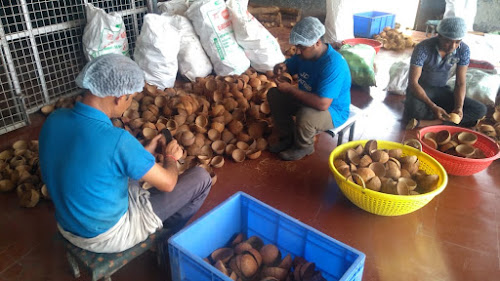Kokonat Bowls empezó en mayo de 2018 con la propuesta de dar una segunda vida a materiales naturales como el coco y el bambú para convertirlos en productos de menaje. Es un proyecto fundado por Antonio García Bolívar, y actualmente también trabajando Maia Pascual Bohnisch. En 2019 abrieron un taller en colaboración con la ONG Lokpanchayat en India que se centra entre otros objetivos en el desarrollo laboral de las mujeres. A través de este proyecto Sonali, Asha, Varsha y Shabnam recibieron un curso de formación para conocer el proceso desde la materia prima hasta el acabado último deseado de los bowls de coco. Esta formación duró poco más de una semana, haciendo pruebas de acabados y familiarizándose con las máquinas y herramientas (cortadora y pulidora). El objetivo de Kokonat bowls en India es seguir creando un impacto positivo para estas mujeres con las que están trabajando, y poder dar cada vez más trabajo a más mujeres, para que ellas puedan seguir empoderándose y conseguir la independencia económica para ellas y para sus hijos.
KOKONAT BOWLS (The Raw Material: Coconut_Part 1)
Kokonat Bowls began in May 2018 with the proposal to give a second life to natural materials such as coconut and bamboo to make them into household products. It is a project founded by Antonio García Bolívar, and currently Maia Pascual Bohnisch is also working on it. In 2019 they opened a workplace project in collaboration with the NGO Lokpanchayat in India, which focuses on the development of women's work, among other objectives. Through this project Sonali, Asha, Varsha and Shabnam received a training course to learn the process from the raw material to the final desired finish of the coconut bowls. This training lasted just over a week, testing the finish and becoming familiar with the machines and tools (cutting and polishing machine). The aim of Kokonat bowls in India is to continue to create a positive impact for these women with who they are working on, and to be able to give more work to more women, so that they can continue to empower themselves and achieve economic independence for themselves and their children.
La materia Prima: El coco
Como proveedores de la materia prima, tuvieron que escoger
entre Indonesia, India y Vietnam, ya que son los lugares donde la
industria del aceite de coco es más abundante.
Finalmente en Vietnam, trabajan con pequeños productores locales. Los tamaños de los cocos son más grandes (hasta 15 cm de diámetro). En India, la materia prima proviene de la zona de Tamil Nadu, de empresas de aceite de coco. Kokonat utiliza los desperdicios del coco. Estos
proveedores, escogen el tamaño deseado (11-12 cm de diámetro) entre
toneladas y toneladas de cáscaras de coco, ya que por lo general no
suelen estar en muy buen estado por estar amontonados sin ningún
cuidado.
Es un proceso costoso, ya que hay
que revisar muchas cáscaras de coco para conseguir las que estén en
perfecto estado. Además, el tamaño del coco en la zona de India es bastante más
pequeño (12-13 cm de diámetro máximo).
Una vez clasificadas las cáscaras de coco, son transportadas a la ONG, que se encuentra a poco más de 1300 km de distancia.
The Raw Material: Coconut
As suppliers of the raw material, they had to choose between Indonesia, India and Vietnam, as these are the places where the coconut oil industry is most abundant.
Finally in Vietnam, they work with small local producers. The sizes of the coconuts are larger (up to 15 cm in diameter). In India, the raw material comes from the Tamil Nadu area, from coconut oil companies. These suppliers choose the desired size (11-12 cm in diameter) from tons to tons of coconut shells, as they are usually not in very good condition because they are piled up without any care.
This is an expensive process, as many coconut shells have to be checked to ensure that they are in perfect condition. In addition, the size of the coconut in the Indian area is much smaller (12-13 cm in diameter at most).
Once the coconut shells have been sorted, they are transported to the NGO, which is just over 1300 km away.
As suppliers of the raw material, they had to choose between Indonesia, India and Vietnam, as these are the places where the coconut oil industry is most abundant.
Finally in Vietnam, they work with small local producers. The sizes of the coconuts are larger (up to 15 cm in diameter). In India, the raw material comes from the Tamil Nadu area, from coconut oil companies. These suppliers choose the desired size (11-12 cm in diameter) from tons to tons of coconut shells, as they are usually not in very good condition because they are piled up without any care.
This is an expensive process, as many coconut shells have to be checked to ensure that they are in perfect condition. In addition, the size of the coconut in the Indian area is much smaller (12-13 cm in diameter at most).
Once the coconut shells have been sorted, they are transported to the NGO, which is just over 1300 km away.
Fuente, información e Imágenes / Information and pictures: Kokonat bowls
Para contactar e informarse lo pueden hacer a través de la página web / To contact them and get information, you can do it through the web page:
y de Instagram: @kokonatbowls.






No hay comentarios:
Publicar un comentario